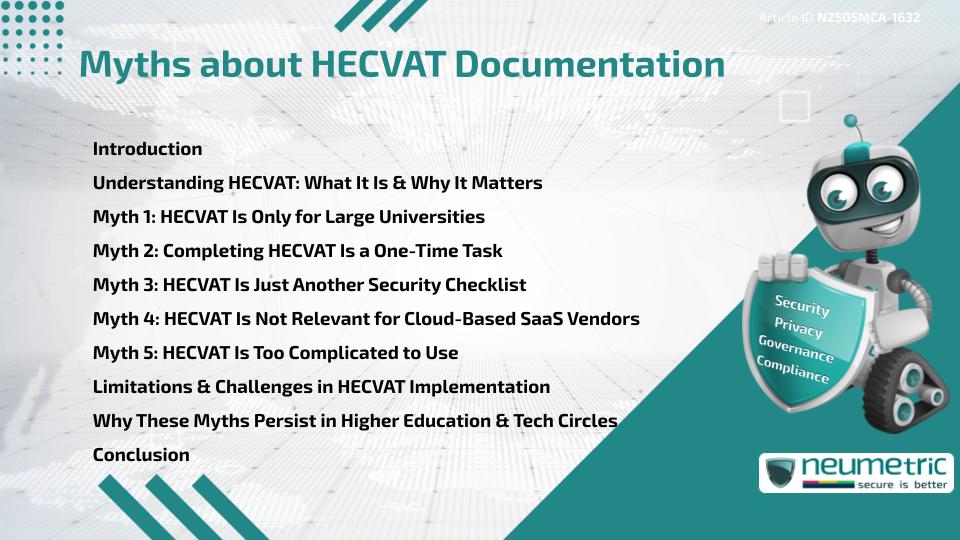Table of Contents
ToggleIntroduction
The Higher Education Community Vendor Assessment Toolkit [HECVAT] has become a Standard in evaluating Cloud Services for colleges & universities. However, despite its widespread use, several misconceptions surround its purpose, process & practicality. These myths about HECVAT documentation can lead to misinformed decisions, overlooked Risks & wasted efforts by Vendors & Institutions alike. In this article, we break down the most persistent myths, clarify the facts & offer actionable insights for navigating HECVAT documentation effectively.
Understanding HECVAT: What It Is & Why It Matters
HECVAT is a Vendor Assessment Tool developed by the higher education community to evaluate Cloud-based Service Providers’ Risk & Security practices. Its aim is to ensure that Third Party Services meet acceptable Cybersecurity Standards before being used in Educational Institutions.
There are different levels of HECVAT, such as the HECVAT Lite & HECVAT Full, depending on the complexity of the service. Vendors often misunderstand its intent, viewing it as either overly bureaucratic or irrelevant to their offering. This confusion has contributed to several myths about HECVAT documentation, which we now explore.
Myth 1: HECVAT Is Only for Large Universities
Many assume HECVAT only applies to large Public Universities with vast IT departments. In reality, any Educational Institution that uses Cloud Services can benefit from HECVAT. Smaller colleges often lack the Cybersecurity resources of larger schools, making a structured toolkit even more essential.
HECVAT is scalable & adaptable. Its standardised questions allow even smaller Institutions to make informed decisions without reinventing the wheel. EDUCAUSE’s HECVAT page explains how all sizes of Institutions are actively using HECVAT today.
Myth 2: Completing HECVAT Is a One-Time Task
Another common myth about HECVAT documentation is the idea that it’s a “fill it out & forget it” process. In truth, HECVAT is not a static document. It should evolve alongside the Service Provider’s security practices & the Institution’s Risk tolerance.
HECVAT responses should be updated regularly, especially after major product updates or changes in Compliance status. Relying on an outdated version could expose users to Risk, much like using an expired ID at airport security. Just as Institutions continuously review their data Policies, Vendors should view HECVAT as an ongoing responsibility.
Myth 3: HECVAT Is Just Another Security Checklist
Some Vendors dismiss HECVAT as a generic list of yes/no questions that can be rushed through. But it’s not just a Compliance checkbox. It’s a Risk communication tool that bridges the gap between Vendors & Institutions.
Each section of the HECVAT touches on real-life concerns: Access Control, Incident Response, Data Encryption & more. When answered carefully, it provides a holistic view of security posture. Reducing it to a basic checklist undervalues its purpose.
Myth 4: HECVAT Is Not Relevant for Cloud-Based SaaS Vendors
This myth contradicts HECVAT’s very foundation. HECVAT was specifically designed for evaluating Cloud-based & SaaS solutions. If anything, SaaS Vendors are among the most frequent users of HECVAT.
With the shift toward remote learning & digital platforms, Institutions increasingly rely on SaaS Vendors. Ignoring HECVAT in such cases can lead to blind spots in Vendor Risk Management. Platforms like REN-ISAC emphasize that SaaS Vendors play a vital role in secure digital infrastructure for education.
Myth 5: HECVAT Is Too Complicated to Use
This myth often comes from Vendors who have seen the full HECVAT & feel overwhelmed. But not every product requires the full version. The HECVAT Lite & HECVAT On-Prem versions simplify the process for less complex services.
With the right support & understanding, using HECVAT becomes much more manageable.
Limitations & Challenges in HECVAT Implementation
While HECVAT is powerful, it’s not without its limits. One challenge is that it doesn’t provide automatic scoring or a pass/fail grade, which can be frustrating for Vendors seeking quick approvals. Another issue is variability in how different Institutions interpret HECVAT answers.
HECVAT’s open-ended format leaves room for subjectivity. This can be both a strength & a weakness. It allows context-based interpretation, but it also requires skilled evaluators on the Institutional side.
Why These Myths Persist in Higher Education & Tech Circles
Many of the myths about HECVAT documentation persist because of lack of training, inconsistent enforcement & poor communication between Buyers & Vendors. New Vendors often assume it’s a paperwork burden, while procurement teams may fail to explain its Risk-driven purpose.
Moreover, tech forums & social media sometimes spread oversimplified takes. Without hands-on experience or guidance, even well-meaning professionals may develop skewed perceptions.
Conclusion
To move past the myths about HECVAT documentation, Stakeholders should:
- Start with the HECVAT Lite version to build familiarity.
- Leverage community resources like EDUCAUSE & REN-ISAC.
- Engage directly with Institutional security teams.
- Treat HECVAT responses as part of continuous Risk Management, not a standalone task.
- Encourage mutual transparency between Vendors & Buyers.
By applying these principles, both parties can foster trust & ensure that security expectations are aligned.
Takeaways
- HECVAT is for Institutions of all sizes, not just large universities.
- It is a living document that requires periodic updates.
- It goes beyond checklists to promote meaningful security dialogue.
- SaaS Vendors are key participants, not exceptions.
- Myths about HECVAT documentation arise from poor communication & misunderstanding.
FAQ
What does HECVAT stand for & why is it important?
The full form of HECVAT is Higher Education Community Vendor Assessment Toolkit. It assists to evaluate Vendor security practices in the context of higher education Institutions.
Is HECVAT only required for Cloud Vendors?
No, while HECVAT is designed for Cloud & SaaS solutions, on-premise providers can also be asked to complete it, using tailored versions like HECVAT On-Prem.
How often should HECVAT responses be updated?
Ideally, Vendors should update their responses at least annually or when there is a significant change in their services or Security Policies.
Do all Institutions interpret HECVAT the same way?
Not always. There can be variations in how responses are evaluated, which is why clear documentation & open communication are crucial.
Can small Vendors handle HECVAT requirements?
Yes. HECVAT Lite is specifically designed for simpler services & helps small Vendors participate without overwhelming documentation.
What happens if a Vendor refuses to complete HECVAT?
In most cases, Institutions may delay or decline procurement until HECVAT documentation is completed to their satisfaction.
Is HECVAT legally required?
HECVAT itself is not a legal requirement, but many universities require it as part of their procurement & Risk Management process.
Does completing HECVAT guarantee approval?
No, it supports decision-making but does not automatically lead to contract approval. It highlights areas of Risk that may require mitigation.
References
Need help?
Neumetric provides organisations the necessary help to achieve their Cybersecurity, Compliance, Governance, Privacy, Certifications & Pentesting goals.
Organisations & Businesses, specifically those which provide SaaS & AI Solutions, usually need a Cybersecurity Partner for meeting & maintaining the ongoing Security & Privacy needs & requirements of their Clients & Customers.
SOC 2, ISO 27001, ISO 42001, NIST, HIPAA, HECVAT, EU GDPR are some of the Frameworks that are served by Fusion – a centralised, automated, AI-enabled SaaS Solution created & managed by Neumetric.
Reach out to us!


